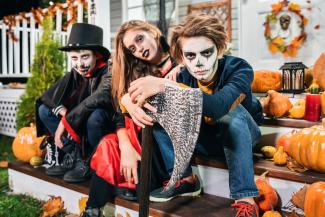
Instructions
Do the preparation task first. Then read the article and do the exercises to check your understanding.
When you think of Halloween, you probably think of pumpkin lanterns, fancy-dress costumes and children asking for sweets. And if you think of a country that celebrates Halloween, you probably think of the United States first. Americans and Canadians have adopted Halloween in a big way, but did you know that Halloween traditions actually come from Ireland, Scotland, England and Wales?
The origins of Halloween
The Celts were people who lived in ancient Britain and Ireland from about 1000 BC and they celebrated a festival called 'Samhain'. Samhain was celebrated on 1 November because that was the end of summer and harvest time (which was associated with food and life) and the beginning of winter (which they associated with death). Have you ever wondered why Halloween colours are orange and black? Orange is related to harvests and black is related to death.
Samhain was the time for ghosts to return to earth for a day. People lit a big fire, wore special clothes made of animal skin and hoped to be safe from the ghosts and the winter.
In early America, the Native Americans and the first Europeans celebrated the end of the harvest, but not Halloween. When many Irish people went to live in America in the 1800s, they brought their Halloween traditions with them and Halloween became popular throughout the country.
Pumpkin lanterns
Many people make pumpkin lanterns to decorate their homes at Halloween. They remove the inside of the pumpkin, cut shapes for the eyes, nose and mouth and place a candle in the empty pumpkin to make a scary face. This tradition came from the Celts, who carved faces into vegetables like turnips and potatoes to scare the ghosts and make them go away. Irish people who came to live in the United States found pumpkins much easier to carve, and the tradition became the one we see today.
Halloween costumes
People of all ages dress up on Halloween. In the UK some of the most popular costumes include witches, vampires, ghosts, skeletons, zombies and monsters. We can trace this tradition back to the Celts, who were afraid of the ghosts that came on Samhain. If they went outside after dark, they covered their faces with masks. They hoped any ghosts they met would think they were ghosts too and would leave them alone.
North Americans wear all kinds of Halloween costumes and not just scary things like witches and ghosts. This is because in the late 19th century, people tried to make Halloween less about ghosts and more about celebrating the season with a party for neighbours and family.
Trick-or-treating
On Halloween children knock on their neighbours' doors and ask for 'treats', like sweets or chocolates. In ancient Britain, Celtic people went from house to house dressed in costumes, asking for gifts and food for the Samhain festival. When Irish people went to live in America, they continued this tradition and it became trick-or-treating. Nowadays going trick-or-treating is so popular in the USA that a quarter of the sweets for the year are sold for this one day!
Around the world
Catholic people around the world celebrate All Saints Day on 1 November and All Souls Day on 2 November. On these days, people remember relatives, friends and other people who have died. In Mexico, people celebrate the Day of the Dead at this time and many dress up as skeletons, and paint skulls on their faces. Nowadays, more and more people around the world are celebrating both the Day of the Dead and Halloween. Will you celebrate this year?
Do you celebrate Halloween or the Day of the Dead?

Comments